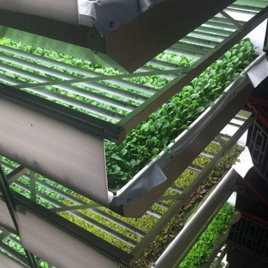The Science
How It Works
Aquaponics combines hydroponics with aquaculture. Hydroponics is the science of growing plants without soil in nutrient-rich water. The nutrients are exactly tailored to nourish and meet the growth requirements of the plants. Plants need nitrogen, phosphorus, potassium, and a variety of other micronutrients to thrive. Normally, in a hydroponics system, synthetic (manufactured) fertilizers added to the water provide these essential nutrients.
Aquaculture is the breeding and farming of aquatic organisms, such as fish, shellfish, and aquatic plants, usually for human consumption. In an aquaponics system, the fish provide nutrients in the form of their “waste,” or excrement. This waste contains nitrogen in the form of ammonia (too much of which can be toxic to fish), along with a variety of nutrients like phosphorus and potassium. Nitrifying bacteria that live in the gravel in the fish tank and on the tank walls convert the ammonia first into nitrites and then to nitrates which the plants can use.


The water in the tank, which contains ammonia, nitrites, nitrates, phosphorus, potassium, and other micronutrients, is continuously pumped into a grow bed where the plants are located. The plants remove the nutrients from this water, and nitrifying bacteria in the grow bed (working together with the tank filter) clean the water by converting excess ammonia into nitrates, which plants use to grow. The clean water is then sent back into the fish tank.
The grow bed and plants act as a biofilter, cleansing the water so that the fish remain healthy. In smaller, backyard aquaponics systems, the grow bed sits on top of the fish tank and the cleansed water from the grow bed drips back into the tank. In aquaponics, the fish, plants, and beneficial bacteria all depend on each other to live.
What are some advantages of growing food in an aquaponics system?
First, it is efficient, producing from one system both food with high protein content (fish) and food with vitamins and minerals (vegetables). Second, aquaponics is mostly a closed system regarding water consumption, because it uses recirculating water. This means it uses minimal water and can be set up in arid areas that don’t have plentiful water. All that is required is food for the fish. Finally, aquaponics is a model for sustainable food production because it integrates hydroponics and aquaculture, meaning that it recycles all of the materials it uses.
The Process
Understanding the flow of water and the life it creates

Water is the main organic compound at the heart of all life in a Tillage ecosystem, creating the perfect condition to promote growth.

These bacteria, most often attributed as nitrosonomas, nitrobacter and nitrospira, are the crucial link between the creation of fish waste and the plants’ ability to absorb the waste as nutrients. Bacteria finally turns Ammonia into nitrates.

Aquatic life in our system creates the nutrients to enrich the water that flow through the system. This creates a healthy culture of the necessary bacteria to formulate chemical balance.

The final product is key, while most farming practices would view the roots as waste and trash Tillage see them as a plant base diet for our fishes. These items alone are great but together they are Tillage and the future of farming.
Fill out the form below to contact us
One of our team members will reach out to you as soon as possible.
